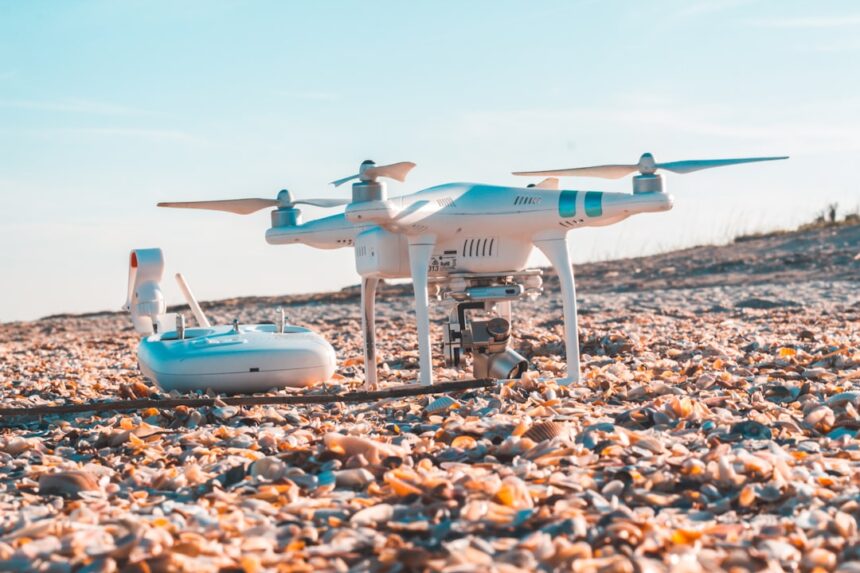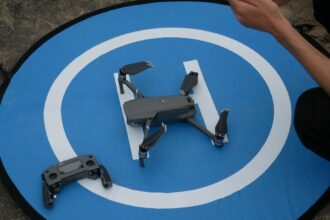In recent years, the proliferation of drones has emerged as a significant concern for airport security and aviation safety. As the technology becomes more accessible and affordable, the number of unauthorized drone flights near airports has surged, leading to heightened anxiety among aviation authorities and airport operators. The ease with which individuals can purchase and operate drones has created a landscape where the potential for misuse is alarmingly high.
This growing threat is not merely theoretical; it has manifested in numerous incidents that have disrupted airport operations and raised serious questions about the safety of air travel. The implications of unauthorized drone activity extend beyond mere inconvenience. Airports are critical infrastructures that handle thousands of flights and millions of passengers daily.
The presence of drones in restricted airspace poses a risk to aircraft during takeoff and landing, where the margin for error is minimal. As such, the aviation industry is compelled to confront this evolving challenge head-on, necessitating a comprehensive understanding of the risks involved and the development of effective countermeasures.
Key Takeaways
- Unauthorized drones pose a growing threat to airports, with the potential for serious risks and hazards.
- Current regulations and laws governing drone use near airports are in place to mitigate the risks and ensure safety.
- Technologies and strategies for detecting and monitoring unauthorized drones are being developed and implemented to enhance airport security.
- Law enforcement and security personnel play a crucial role in responding to unauthorized drones and ensuring the safety of airport operations.
- Collaborative efforts between airports, government agencies, and industry partners are essential in addressing the drone threat and implementing effective mitigation plans.
The Potential Risks and Hazards Posed by Unauthorized Drones
Unauthorized drones present a myriad of risks that can jeopardize both aircraft and passengers. One of the most pressing concerns is the potential for mid-air collisions. Drones, particularly those that are larger or equipped with heavy payloads, can cause catastrophic damage if they collide with an aircraft.
The Federal Aviation Administration (FAA) has documented instances where drones have come dangerously close to commercial flights, underscoring the urgent need for effective monitoring and control measures. Moreover, the hazards posed by drones are not limited to physical collisions. The presence of an unauthorized drone can lead to significant disruptions in airport operations, including flight delays and cancellations.
Such disruptions can have cascading effects on airline schedules, passenger itineraries, and overall airport efficiency. In extreme cases, the sighting of a drone can prompt emergency responses that divert resources away from other critical security needs, further complicating the operational landscape at airports.
Current Regulations and Laws Governing Drone Use Near Airports

In response to the growing threat posed by unauthorized drones, regulatory bodies have implemented a framework of laws and guidelines aimed at mitigating risks. The FAA has established specific regulations that govern drone operations, particularly in proximity to airports. For instance, drones are prohibited from flying within five miles of an airport without prior notification to air traffic control.
These regulations are designed to create a buffer zone that minimizes the risk of drone incursions into controlled airspace. However, enforcement of these regulations remains a challenge. Many drone operators may be unaware of the legal restrictions or may choose to ignore them altogether.
This lack of compliance highlights the need for ongoing education and outreach efforts to inform drone users about the importance of adhering to established guidelines. Additionally, as drone technology continues to evolve, regulatory frameworks must adapt to address new challenges and ensure that safety remains paramount in aviation operations.
Technologies and Strategies for Detecting and Monitoring Unauthorized Drones
| Technology | Advantages | Disadvantages |
|---|---|---|
| Radar Systems | Effective for long-range detection | Expensive and can be affected by weather |
| Radio Frequency (RF) Detection | Can detect drones without GPS | Limited range and can be affected by interference |
| Acoustic Sensors | Can detect drones by sound | Limited range and can be affected by background noise |
| Optical and Thermal Imaging | Can detect drones visually and at night | Limited range and can be affected by weather conditions |
To combat the threat posed by unauthorized drones, airports are increasingly turning to advanced technologies designed for detection and monitoring. Radar systems specifically tailored for drone detection have been developed, allowing security personnel to identify unauthorized flights in real-time. These systems can differentiate between various types of aerial vehicles, providing critical information that aids in assessing potential threats.
In addition to radar technology, airports are exploring the use of radio frequency (RF) detection systems that can intercept signals between a drone and its operator. By identifying these signals, security teams can pinpoint the location of the drone’s pilot, facilitating a more effective response. Furthermore, integrating artificial intelligence into monitoring systems enhances their ability to analyze data and predict potential drone incursions based on historical patterns and flight behaviors.
The Role of Law Enforcement and Security Personnel in Responding to Unauthorized Drones
Law enforcement agencies and airport security personnel play a crucial role in responding to unauthorized drone incidents. When a drone is detected within restricted airspace, immediate action is required to assess the situation and mitigate potential risks. Security teams are trained to evaluate the threat level posed by the drone, considering factors such as its size, altitude, and proximity to aircraft.
In many cases, law enforcement may be called upon to investigate further. This could involve tracking down the operator of the drone or implementing measures to neutralize the threat. Collaboration between airport security and local law enforcement agencies is essential for ensuring a coordinated response that prioritizes safety while minimizing disruptions to airport operations.
Collaborative Efforts between Airports, Government Agencies, and Industry Partners to Address the Drone Threat

Addressing the challenges posed by unauthorized drones requires a collaborative approach involving airports, government agencies, and industry partners. Recognizing that no single entity can tackle this issue alone, stakeholders are increasingly working together to share information, resources, and best practices. This collaboration fosters a more comprehensive understanding of the drone threat landscape and enables the development of effective countermeasures.
Joint initiatives may include training programs for airport personnel on drone detection and response protocols, as well as public awareness campaigns aimed at educating drone operators about safe flying practices near airports. By fostering a culture of cooperation among all parties involved, airports can enhance their resilience against unauthorized drone activity while promoting responsible drone use within their communities.
Case Studies of Drone Incidents at Airports and Lessons Learned
Several high-profile incidents involving unauthorized drones have underscored the urgency of addressing this issue within airport environments. One notable case occurred at Gatwick Airport in December 2018 when sightings of drones led to widespread flight cancellations and significant disruptions over several days. This incident highlighted vulnerabilities in airport security protocols and prompted a reevaluation of existing measures.
The lessons learned from such incidents are invaluable for shaping future responses to drone threats. Airports have since implemented more robust detection systems and improved communication protocols among security personnel and law enforcement agencies. Additionally, these case studies serve as cautionary tales that emphasize the importance of proactive measures in preventing similar occurrences in the future.
Best Practices for Developing and Implementing Drone Mitigation Plans at Airports
Developing effective drone mitigation plans requires a multifaceted approach that encompasses technology, training, and community engagement. Best practices include conducting thorough risk assessments to identify vulnerabilities specific to each airport’s operational environment. By understanding potential threats, airports can tailor their mitigation strategies accordingly.
Furthermore, engaging with local drone communities can foster a sense of responsibility among operators.
By creating an inclusive dialogue between airport authorities and drone enthusiasts, airports can cultivate a culture of safety that benefits all stakeholders involved.
Training and Education for Airport Personnel on Identifying and Responding to Unauthorized Drones
Training airport personnel on how to identify and respond effectively to unauthorized drones is paramount in enhancing overall security measures.
Additionally, simulations or tabletop exercises can provide personnel with hands-on experience in responding to potential drone incidents.
These training initiatives not only equip staff with essential skills but also foster a heightened awareness of the evolving nature of drone threats within airport environments.
Public Awareness and Outreach Campaigns to Promote Responsible Drone Use Around Airports
Public awareness campaigns play a vital role in promoting responsible drone use around airports. By educating the general public about the risks associated with flying drones near critical infrastructures, authorities can encourage compliance with regulations while fostering a culture of safety. Outreach efforts may include informational brochures distributed at local retailers selling drones or community events focused on aviation safety.
Engaging with schools or youth organizations can also help instill responsible flying practices among younger generations who may be interested in operating drones recreationally.
The Future of Airport Security and the Continued Evolution of Drone Detection and Mitigation Technologies
As technology continues to advance at an unprecedented pace, so too will the methods employed for detecting and mitigating unauthorized drones at airports. Future developments may include enhanced radar systems capable of tracking multiple drones simultaneously or even automated response mechanisms that can neutralize threats without human intervention. Moreover, ongoing research into artificial intelligence will likely yield sophisticated algorithms capable of predicting potential drone incursions based on real-time data analysis.
As airports adapt to these technological advancements, they will be better equipped to safeguard against emerging threats while ensuring the safety and efficiency of air travel remains uncompromised. In conclusion, addressing the growing threat posed by unauthorized drones at airports requires a comprehensive approach that encompasses regulation, technology, training, collaboration, and public awareness. By implementing best practices and fostering a culture of responsibility among all stakeholders involved, airports can enhance their resilience against this evolving challenge while ensuring safe skies for all travelers.
In recent years, the increasing prevalence of drones has posed significant challenges to airport security, necessitating innovative solutions to protect these critical infrastructures. One approach to addressing this issue is discussed in an article on In The War Room, which explores various strategies and technologies being implemented to safeguard airports from unauthorized drone activities. The article delves into the integration of advanced detection systems and the development of regulatory frameworks aimed at mitigating potential threats posed by drones, ensuring the safety and efficiency of airport operations.
FAQs
What are drones?
Drones, also known as unmanned aerial vehicles (UAVs), are aircraft that are operated without a human pilot on board. They can be controlled remotely by a person on the ground or can fly autonomously using pre-programmed flight plans.
Why is it important to protect airports from drones?
Protecting airports from drones is important to ensure the safety and security of air travel. Drones can pose a threat to aircraft by potentially colliding with them, causing damage to engines or other critical components. They can also disrupt airport operations by flying into restricted airspace, leading to flight delays and cancellations.
What are the risks associated with drones at airports?
The risks associated with drones at airports include potential collisions with aircraft, interference with air traffic control systems, and disruption of airport operations. Drones can also be used for malicious purposes, such as smuggling contraband or conducting surveillance on airport facilities.
How can airports protect themselves from drones?
Airports can protect themselves from drones by implementing a combination of technological solutions and operational procedures. This may include the use of drone detection and countermeasure systems, training staff to respond to drone sightings, and collaborating with law enforcement agencies to enforce regulations regarding drone operations near airports.
What are some technologies used to detect and counter drones at airports?
Technologies used to detect and counter drones at airports include radar systems, radio frequency (RF) sensors, electro-optical and infrared (EO/IR) cameras, and drone jamming devices. These technologies can help airports identify and track unauthorized drones in their vicinity and, if necessary, disrupt their control signals to prevent them from posing a threat.
What regulations are in place to prevent drones from operating near airports?
Many countries have regulations in place to prevent drones from operating near airports. These regulations typically establish no-fly zones around airports and require drone operators to obtain permission before flying in controlled airspace. Violating these regulations can result in fines or other penalties.




